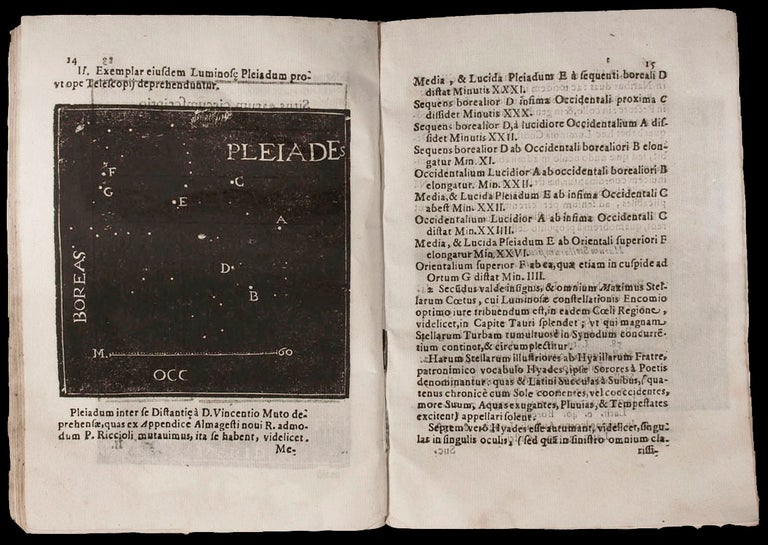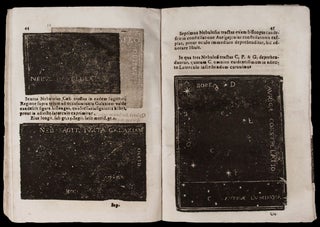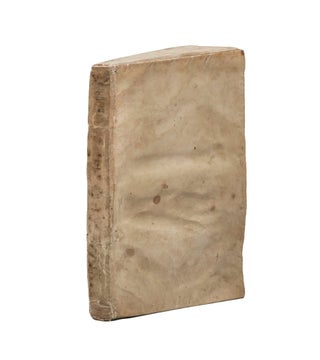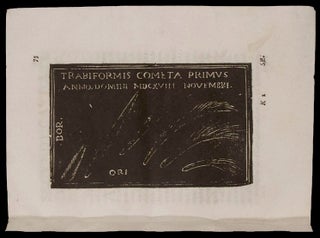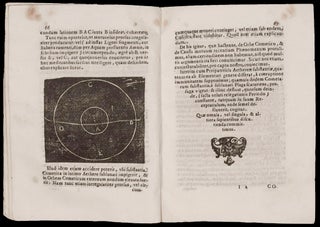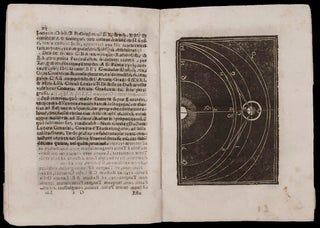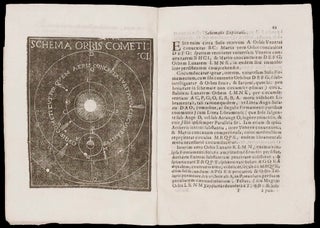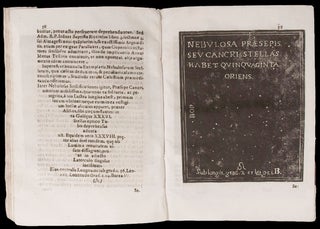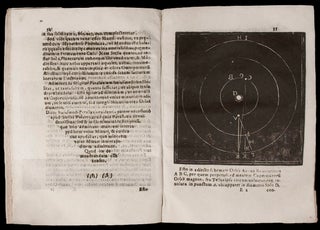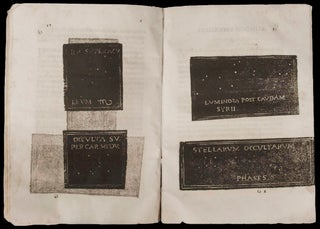De systemate orbis cometici de que admirandis coeli characteribus, opuscula duo, in quorum primo cometarum causae disquiruuntur, & explicantur... In secondo vero quid, quales quotue sint stellae luminosae; nebulosae; necnon, & occultae, manifestantur, & rerem caelestium studiosis commendantur.
4to [21.0 x 15.0 cm], 2 parts in one vol., (viii) pp., 102 pp., 1 f. blank; (iv) pp., 60 pp., (8) pp. including terminal blank, with 39 white-on-black woodcuts in text (12 full-page, 14 half-page, and 13 quarter-page). Bound in contemporary limp vellum. Binding well preserved. A few minor spots, blindstamp on front flyleaf; inscription on title (crossed through) “Fra Giulio Amico J M C” and signature of same on f. †4v.; 18th-century astronomical annotations on pastedowns. A very clean, crisp copy. First edition of this exceptionally rare and remarkable book on nebulae, the first of its kind, illustrated with striking white-on-black woodcuts. It is also a work of profound cosmological speculation placing it at the forefront of astronomical thought in the 17th century. Giovanni Battista Odierna (1597–1660) suggests in this work that all nebulae are composed of stars or stellar matter and that the centre of the Universe may lie far outside the solar system. Odierna was a Sicilian priest and disciple of Galileo who presented him with a telescope of medium focal length. Inspired by Galileo’s Sidereus nuncius, he began a systematic investigation of nebular objects, the first of its kind. This study had not been pursued by other astronomers for various reasons, among them the emphasis on cataloguing fixed stars, the inadequacies of early telescopes for viewing objects of lower surface brightness, and finally because the “systematic observations of nebulae would have inevitably called for a cosmological theory on ‘the construction of the heavens’ a theory with which the seventeenth century, still laboriously digesting the Copernican revolution intensified by the debate on the teachings of Galileo, could hardy cope” (Serio et al., op. cit.). The first part of the book is devoted to comets and was written by Odierna specifically to distinguish them from nebulae. “Hodierna regarded comets as heavenly bodies very different from nebulae: besides their kinematical differences - comets have a rapid motion while nebulae have none - he thought that there was a more profound difference, the comets being made out of terrestrial substance, the nebulae being made out of stars and consequently, according to him, out of Lux Primogenita” (ibid.). The second part of the work is devoted to nebulae. He records “some forty-three nebulous objects of which nineteen have been shown to be true nebulae or star clusters, nine can be recognised as evident asterisms, while the remaining fifteen evade identification at the present time. Of the nineteen ‘true’ nebulae, eleven (or twelve if we include the possible NGC 2451) were original discoveries. (He was unaware that the Andromeda Nebula and the cluster in Vulpecula, Cr 399, had been previously catalogued by Al-Sufi) … It is a truly remarkable total, especially when one considers that in this same half-century following the invention of the telescope, the rest of the astronomical community discovered precisely one new object (M42, by Pieresc)” (Jones, p. 188). Odierna’s “daring cosmological conceptions... [appear] to be the true reason for the book. Odierna hypothesised that all nebulae could be ultimately resolved into stars. The fourth section of the book is devoted to a cosmological discussion about the construction of the starry sky, central to which is what Odierna calls an “irrefutable axiom”: ‘The stars created with this world, which shine similarly to the Sun in their immense distances, were not located all at the same distance from the Earth but they were distributed by the almighty Creator in various and multiple intervals of the sensible world, in the same way that the planets were set in motion around the Sun along different orbits’ “As a consequence of this axiom stars can appear of different magnitudes both because of their intrinsic differences and because of their different distances. This leads Odierna to put forward the following astonishing speculation: ‘How does it happen that the stars appear scattered in the aether, so that no harmony can be seen in their order, that larger ones are seen to join the smallest in a disorderly fashion and various aggregations? Could it be, perhaps, that with our eye outside of their series, our mind cannot perceive their order? Or could it be that the series of Divine order are very different from human order, so that the stars in the immense sky are not on the same surface of a sphere centred on us, but are rather at different depths in the aether, where the series of fixed stars appear to be disordered, although perhaps they are ordered around a centre of the universe different from Earth, in the same way as the planets, which are ordered around the Sun appear very disordered to us’ “At a time when the mere removal of the centre of the Universe from the Earth to the Sun had caused so much damage to scientific thought in Italy, it is certainly astonishing that a churchman in Sicily, where the Inquisition was particularly influential, could dare to doubt, even in this hypothetical way, that the real centre of the Universe was not the Earth, nor even the Sun” (quoted and paraphrased from Serio et al, op. cit.). Although Odierna corresponded with Riccioli, Huygens, Schott, and other leading scientists of his day, his work was long neglected, and his provincial position compounded his obscurity until modern times. OCLC records only five copies, none in North America: BL, Thuringer Landesbibliothek, ETH Zurich, UCL, and BNC; Grassi adds a copy in the Palermo Observatory Library. * Riccardi I 214.6; Mira I 477; Libri 1861 n 1833; Serio, Indorato, and Nastasi, “G.B. Hodierna’s Observations of Nebulae and his Cosmology,” Journal for the History of Astronomy, vol. xvi (1985), pp. 1-36; K.G. Jones, “Some notes on Hodierna’s Nebulae,” Journal for the History of Astronomy, vol. xvii (1986), pp. 187-8.
Sold

